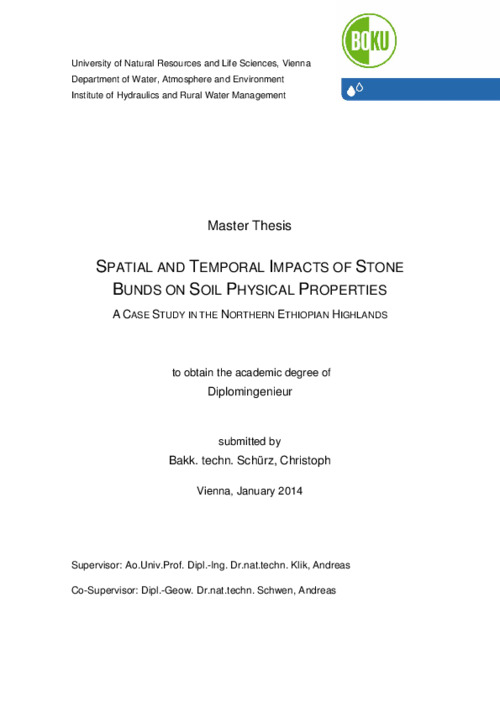Spatial and Temporal impacts of stone bunds on soil physical properties: a case study in the Northern Ethiopian Highlands
Abstract
Central issue of rain fed agriculture systems in the Ethiopian highlands is to store rain 
water in the soil during the rainy season. The aim is to maximize plant available water and 
to reduce surface runoff and soil erosion. Stone bunds are a common practice for soil and 
water conservation, influencing the translation processes of surface runoff. However, 
changes in surface hydrology affect the temporal and spatial properties of soil physical 
parameters. 

The objective of this work is to find a relationship between the spatial distribution of soil 
properties and the location of the stone bunds, but also to monitor the temporal behavior 
of those soil parameters, to better understand the impact of stone bunds on soil water 
movement. The research area is located in the Gumara-Maksegnit watershed in Northern 
Ethiopia. There, two representative transects were selected: One transect crosses three 
fields with soil and water conservation measures applied perpendicular to them on a 
length of approximately 71 m. The second transect crosses the same hill slope in an area 
without conservation structures at a length of 55 m. During the rainy season in 2012 soil 
physical properties were monitored in specific spatial and temporal intervals. The 
measurements included bulk density, soil texture, and volumetric water content. Tension 
infiltration experiments were performed to determine saturated hydraulic conductivity for 
areas near stone bunds and the center of the fields on one hand, but also to derive soil 
water characteristics for the certain positions at the hill slope. Slope steepness and stone 
cover along the transects were assessed, using survey and photogrammetric analysis. 

The analyses that were used in this approach were able to reveal spatial and temporal 
characteristics of the assessed soil properties under the influence of stone bunds. For 
near surface volumetric water content a clear periodic behavior along the stone bunds 
was found, with significantly higher values in the vicinity of the stone bunds. Additionally, 
an early increase in water content over the rainy season was found for the transect with 
SWC. The bulk density showed significantly lower values in the zones where 
accumulation of sediment material takes place. Saturated hydraulic conductivity but also 
soil water characteristics show temporal changes but also spatial differences that are 
most likely induced by differences in soil structure. The strongest spatial relationship was 
found for inclination and near surface soil water content

